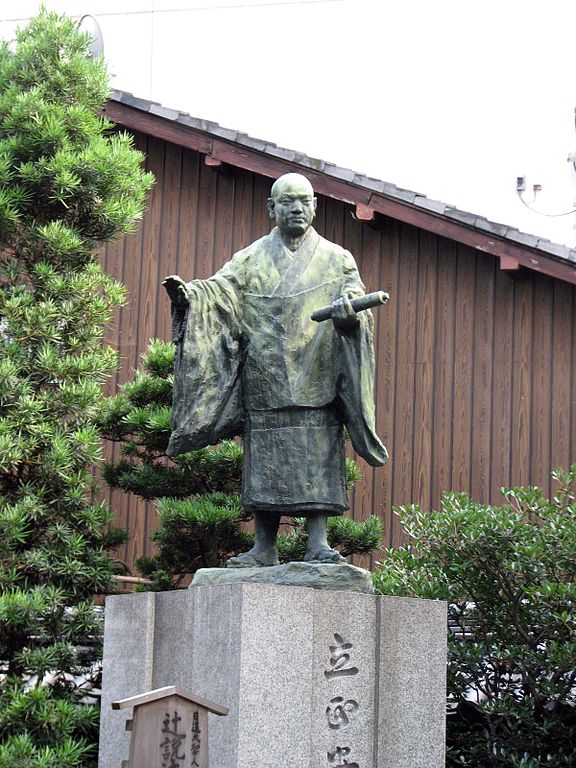Nichiren’s career unfolded as an attempt to revive devotion towards the Lotus Sutra as he believed, along with many others, that the string of calamities Japan was going through at the time was caused by a neglect of its teachings. Nichiren’s thought focused on working out a new practice, based on the Lotus Sutra, that would enable all people regardless of capacity, to attain Buddhahood.
As she starts her analysis of Nichiren’s doctrine, Jacqueline Stone asks: “What exactly about the Lotus Sutra Nichiren thought worth dying for?”
The realisation of Buddhahood in “the moment of chanting the daimoku lies at the heart of Nichiren’s mature teaching.” It is a question of ‘embracing the Lotus Sutra’, as this embracing is ‘the moment of faith’ that allows this realisation. The doctrine of “three thousand realms in a single thought-moment,” as first articulated by Zhiyi (Chih-i), the founder of the Chinese Tiantai school, had been Nichiren’s starting point. “It was by means of this doctrine that Nichiren [had] sought to legitimize his own position within the Tendai Buddhist tradition … and at the same time, also expressed the “innovative” aspect of his own teaching.”
The doctrine of the “three thousand realms in a single thought-moment” (ichinen sanzen) is found both in the Lotus Sutra and in other Mahayana texts. “Ichinen” means moment, “sanzen” means “all three thousand realms of phenomena.” Each moment of existence of all living beings (ichinen) is endowed with all three thousand realms of phenomena (sanzen). How did Zhiyi arrive at the number “three thousand?” Here is the breakdown: the “ten worlds,” also known as the “ten spiritual realms,” include the ten different conditions of life at any given moment (hell beings, hungry ghosts, animals, asuras, human beings, devas, sravakas, pratyekabuddhas, bodhisattvas and buddhas). Each member of the “ten worlds” has the capacity to experience the other nine worlds as well. So there are ten worlds within the “ten worlds.” Within each of these, according to a doctrine unique to Tiantai/Tendai, there are ten “factors of life” or ten “suchnesses” (form, nature, entity, potency, function, primary cause, secondary cause, latent effect, manifest effect, consistency) and these “ten factors of life” are experienced within the “three realms of existence” (the five skandhas, the realm of living beings and the realm of the environment).
But, of course, “three thousand worlds” really means “all” worlds, and, more precisely and significantly, “all interrelated worlds.” What then, is meant by ichinen sanzen is that within each “thought-moment,” we are connected with these interrelated worlds, and have the potential of “being” in any of these worlds. The “three-thousand worlds” are really the many different ways reality appears to us according to our life state.
Nichiren’s re-interpretation does not call into question the meaning of the ichinen sanzen doctrine. It concerns the contrast between a consideration of this doctrine “in principle,” and its realisation “in actuality,” the argument being that Zhiyi’s did not go beyond the “principle,” i.e., its ontological aspect, while Nichiren provided a practice for its realisation “in actuality”, i.e., its realisation as a live embodiment.
“In a letter to a follower, Nichiren wrote: “There are two methods of contemplating the three thousand realms in one thought-moment. One is that of principle (ri), and the other that of actuality (ji). In the time of Chih-i and Saicho, that of principle was appropriate. Now is the time for that of actuality. Because this [form of contemplation] is superior, the great ordeals [attending its propagation] are also more severe. One [i.e., that of principle] is ichinen sanzen of the trace teaching (shakumon] while the other is ichinen sanzen of the origin teaching (honmon).”
What is above referred to as the “trace teaching” is that found in the first fourteen chapters of the Lotus Sutra. “It represents Chih-i’s attempt to conceptualize the true aspect of the dharmas” referred to in the ‘Skillful Means’ chapter.” In contrast, the “origin teaching” is that of the last fourteen chapters of the Lotus Sutra. Nichiren argues that the ichinen sanzen doctrine is “found only in the origin teaching of the Lotus Sutra, hidden in the depths of the text of the ‘Fathoming the Lifespan’ chapter.”
Nichiren elaborates in the following passage: “When one arrives at the origin teaching, because [the view that the Buddha] first attained enlightenment [in this lifetime] is demolished, the fruits of the four teachings are demolished.” What is rejected here is the “linear view of practice and attainment, in which efforts are first made and then Buddhahood is realized as a later consequence.” In the “origin” teaching of the “Fathoming the Lifespan” chapter with its revelation of the Buddha’s original enlightenment, as seen through the lens of contemplative insight (kanjin), cause (practice) and effect (attainment of Buddhahood) are present simultaneously. This simultaneity of cause and effect is key to Nichiren’s argument. It can be best remembered when one knows that the lotus, after which the Lotus Sutra was named, was chosen because, unlike most flowers, it puts forth flowers and fruit at the same time, and was therefore a fitting illustration for the simultaneity of cause and effect.
“The nine realms are inherent in the beginningless Buddha realm; the Buddha realm inheres in the beginningless nine realms. This represents the true mutual inclusion of the ten realms, the hundred realms and thousand suchnesses, and the three thousand realms in one thought-moment.” Stone notes that “it is passages such as this that led Tamura Yoshiro to assert the Nichiren maintained the notion of original enlightenment in the depths of his mature thought.”
Source:
Jacqueline I. Stone – Original Enlightenment and the Transformation of Medieval Japanese Buddhism

